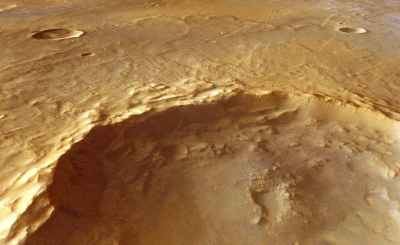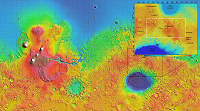Craters expose action of groundwater beneath Martian highlands
27 June 2012
A new study of the ancient, cratered highlands of Mars has detected numerous exposures of minerals that were altered by underground water during the planet's early history. The data indicate that subsurface water persisted for prolonged periods of time during the first billion years of the planet's existence.
 |
|
Excavating water-rich rocks in Tyrrhena Terra. |
At the present time, atmospheric pressure is so low on Mars that surface water cannot exist on its surface. However, studies made by orbiting spacecraft and surface rovers show that Mars was once much warmer and wetter than it is today.
The most obvious evidence is the presence of landforms such as dry valleys and fossil deltas, which were almost certainly created by running water. Other compelling evidence is provided by widespread, but fairly localised, detections of hydrated minerals – the result of chemical alteration of rocky material due to the presence of water.
Aqueously altered minerals – generally classified as hydrated silicates and phyllosilicates – are absent from most of the Martian surface, except in a number of outcrops of the oldest geologic units, indicating that the planet has been dry for most of its history. However, an international team of scientists reports in the journal Icarus that these tell-tale minerals have been detected in Tyrrhena Terra, a region of ancient highlands that is sandwiched between the northern plains of Isidis Planitia and the huge Hellas impact basin.
The detections of hydrated minerals were made with two imaging spectrometers: OMEGA (Observatoire pour la Minéralogie, l'Eau, les Glaces et l'Activité) on board ESA's Mars Express and CRISM (Compact Reconnaissance Imaging Spectrometer for Mars) on NASA's Mars Reconnaissance Orbiter.
OMEGA provides nearly full coverage of the Martian surface at resolutions ranging from a few hundreds of metres to a few kilometres per pixel, while CRISM, which has a resolution of 15-20 m per pixel, can be targeted to provide mineralogical close-ups for selected locations.
The spacecraft observations revealed hydrated silicate-bearing outcrops at 175 different sites in Tyrrhena Terra, almost all of which are associated with ejecta blankets, crater walls and rims, and central uplifts inside craters. The diameters of the craters where these minerals were detected ranged from 84 km to less than 1 km.
 |
|
Tyrrhena Terra on map of Mars. |
Although the region is dissected by numerous valley networks, aqueously altered rocks are rarely visible between the craters in Tyrrhena Terra. This implies that the chemical weathering revealed by the craters was not associated with weathering by liquid water at the surface, unlike several other regions on Mars where surface weathering seems to have taken place.
So how did the hydrated silicates form in Tyrrhena Terra? Two main hypotheses have been proposed.
One possibility is that the chemical alteration was due to the impact process. A hydrothermal system could arise in the crater peak and rims, forming minerals such as serpentine, chlorite and smectite. However, this process does not explain the presence of similar hydrated silicates on the central peak and on the edge of the blankets of ejecta which have been blasted out of the craters.
Furthermore, no surface features associated with possible hydrothermal systems, such as vents or fractures, were observed on the crater floors. Finally, the presence of numerous hydrated outcrops associated with smaller craters, some less than 1 km across, cannot be explained by hydrothermal systems induced by those less energetic impacts.
The team concludes that this hypothesis seems unlikely to be the only process associated with the rock hydration, and may have contributed only by modifying the mineralogy of the floor of the largest craters in the region.
Their preferred explanation is that the hydrated minerals were formed underground in the presence of ground water. The buried hydrated silicate-bearing rocks were then exposed and exhumed by later impacts. These impacts transported the hydrated minerals mechanically, without significant mineralogical transformations.
The presence of a few phyllosilicate-bearing outcrops on a few buttes in the region, far from visible craters, also reinforces the idea that the crust has been broadly altered, not only around craters.
Phyllosilicates are hydrous minerals formed by interaction between rock and liquid water. This important group of minerals includes the micas, chlorite, serpentine, talc and clays - primary products of chemical weathering of rocks. The minerals form at different temperatures and seem to be located at different depths, consistent with temperatures of up to 300 degrees Celsius a few kilometres beneath the surface.
"These minerals are associated with fresh craters that post-date any aqueous activity," said Damien Loizeau, an ESA Research Fellow and lead author of the study. "They probably represent ancient hydrated terrains that have been excavated by the crater-forming impacts. These impacts have revealed the composition of the Noachian crust, which was chemically weathered more than 3.7 billion years ago."
Finally, hydrated silicates have not been detected in or near small craters (diameter < 5 km) on the smooth volcanic plains of Tyrrhena Terra, although they are numerous on the Noachian dissected plateaus. This demonstrates that the presence of hydrated silicates does not depend on the impact process, but rather on the pre-alteration of the impacted terrain.
The presence of hydrated silicates on larger craters of the smooth plains can be explained by excavation: the lava plain is thin enough for larger craters to excavate rocks underneath, from the buried Noachian unit. Hence, hydrated silicate-bearing craters in volcanic plains illustrate the variation in plain thickness and excavation by impacts of buried hydrated rocks.
"The large range of crater sizes studied, from less than 1 km to 84 km wide, indicates that these hydrated silicates are were excavated from depths of tens of metres to kilometres," said Damien Loizeau. "The composition of the rocks is such that underground water must have been present there here for a long period of time in order to have altered their chemistry."
"Water circulation occurred several kilometres deep in the crust some 3.7 billion years ago, before the majority of craters formed herein this region," said co-author Nicolas Mangold, from the Laboratoire de Planétologie et Géodynamique, Université de Nantes, France. "The water generated resulted in a wide range of chemical changes in the rocks that reflect low temperatures near the surface to high temperatures at depth, but without any a direct relationship to the surface conditions at the that time."
"The role of liquid water on Mars is of great importance for its habitability and this study using data from Mars Express describes a very large zone where groundwater was present for a long time," said Olivier Witasse, ESA's Mars Express project scientist.
Reference paper
D. Loizeau et al., "Characterization of hydrated silicate-bearing outcrops in Tyrrhena Terra, Mars: Implications to the alteration history of Mars", 2012, Icarus, 219, 476-497, doi:10.1016/j.icarus.2012.03.017
Contacts
Damien Loizeau
ESA Research Fellow
Research and Scientific Support Department
Directorate of Science & Robotic Exploration
ESA, The Netherlands
Email: Damien.Loizeau![]() esa.int
esa.int
Phone: Phone: +31 71 5654470
Nicolas Mangold
Laboratoire de Planétologie et Géodynamique,
Université de Nantes, France
Email: Nicolas.Mangold![]() univ-nantes.fr
univ-nantes.fr
Olivier Witasse
Mars Express Project Scientist
Research and Scientific Support Department
Directorate of Science & Robotic Exploration
ESA-ESTEC, The Netherlands
Email: Olivier.Witasse![]() esa.int
esa.int
Phone: +31 71 5658015

